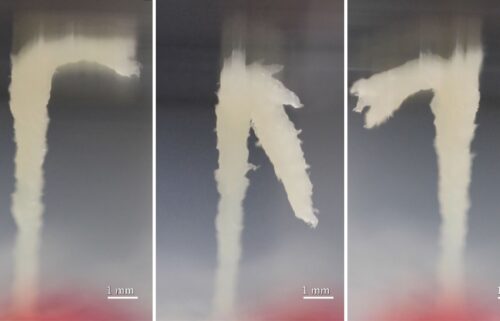This smiling robot has a face covered in ‘living’ skin
By Rebecca Cairns, CNN
(CNN) — The soft, pink blob stares at the camera with glassy eyes — before pulling its face into a dimpled smile.
While it might look like the stuff of nightmares, this tiny robot covered in living skin could mark a step forward in the quest to make robots more human-like. It’s the work of researchers in Japan, who say they have discovered a new way to bind living skin tissue to a mechanical robotic surface.
The team was led by Professor Shoji Takeuchi, of the Institute of Industrial Science at the University of Tokyo. Previously, he developed a “living” robot skin — using collagen, a fibrous protein in human skin, and human dermal fibroblasts, the main cell type in connective tissue — that could be applied to a robotic finger and bend without breaking.
For its new technique, the team was inspired by the natural structure of human skin ligaments to create “anchors” using a collagen gel applied to small, V-shaped holes on the robot’s surface. The new method provides “a more seamless and durable attachment,” says Takeuchi.
For its new technique, the team was inspired by the natural structure of human skin ligaments to create “anchors” using a collagen gel applied to small, V-shaped holes on the robot’s surface. The new method provides “a more seamless and durable attachment,” says Takeuchi.
Takeuchi isn’t alone in his efforts to make robots more human-like.
Ameca, often called the world’s “most advanced humanoid robot,” employs artificial intelligence to talk with people and react appropriately to their responses. One of the things that makes her appear more realistic than other robots is her eyes, says Will Jackson, the founder and CEO of Engineered Arts Ltd (the company behind Ameca).
“Eyes are the windows to the soul. We read each other’s emotions by eye contact,” Jackson told CNN earlier this year, adding that with a “finite amount of motion” available in the robot’s head, eyes provide “the most expressive capability.”
Unlike the 3.5 million industrial robots already working behind the scenes in sectors such as automotive manufacturing and electronics, humanoids like Ameca, or Hanson Robotics’ Sophia and Grace, are destined for people-facing roles such as hospitality, health care, or education. Currently, they don’t have a huge range of motion for their facial expressions, creating an “uncanny valley” effect — a phenomenon that can make people uncomfortable with things that are trying to be human-like, but miss the mark.
“Realistic facial expressions enhance the robot’s ability to communicate and interact with humans more naturally and effectively,” says Takeuchi. “This is particularly important in applications such as healthcare, where empathy and emotional connection can significantly impact patient care.”
Building robots that can feel
The research, details of which were published in the journal Cell Reports Physical Science this month, is an exciting development for the robotics field, says Yifan Wang, an assistant professor at the school of mechanical and aerospace engineering at Nanyang Technological University, Singapore. Wang’s work focuses on “soft robots” that mimic biological creatures.
Skin, the largest organ of the human body, is vital for sensory perception, feeling temperature, humidity, and the textures of objects, says Wang. “This kind of feature in biological systems is currently, with artificial robots, still very difficult to achieve,” he adds.
But the research at the University of Tokyo enables a “hybrid solution” between the soft and traditional robotics fields that is “very interesting,” says Wang. Robots are often covered in a material made to resemble flesh, such as silicone, which is attached via an adhesive or fastening — but this can lead to the skin falling off or breaking, says Wang.
The new method, on the other hand, offers a way of “adhering the skin onto a rigid surface very nicely, so that it does not detach easily and forms a very good interface between the rigid and soft,” he says.
For Wang, the most exciting implications of this research are around developments in the “sensing capability of robots.”
“Our human skin has these very delicate, high-density sensors on the surface, which currently you can still not quite achieve using some synthetic materials,” says Wang. “(But) if we use biological skin on those traditional robots, we can achieve a similar type of sensing of different features.”
Takeuchi and his team hope to add more sensory functions in the next research phase, “to make the skin more responsive to environmental stimuli,” he says.
However, ensuring the consistency and quality of the living skin might not be so easy, says Takeuchi.
That’s why another part of his research is exploring how to create a vascular system for the robotic skin — the network of vessels and veins that carry blood and lymphatic fluids all over the body — that can provide the necessary nutrient supply to maintain the skin’s health over time. This would give the skin more moisture, “enhancing its durability and longevity,” says Takeuchi.
Something like this would “need a lot of work in terms of engineering” says Wang — but if they pull it off, it would give humanoids the ability to look and feel like people in the future.
The-CNN-Wire
™ & © 2024 Cable News Network, Inc., a Warner Bros. Discovery Company. All rights reserved.


